The overwhelming majority of the country’s academics, media pundits and intellectuals in their ivory towers seem unable to connect dismal quality primary education being dispensed in rural India with rising farm suicides Dilip Thakore
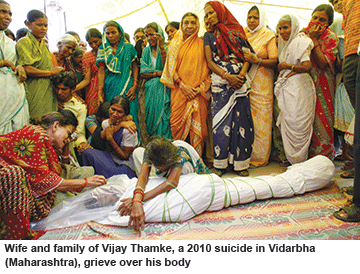 ON APRIL 28, HARESHBHAI JASMATBHAI RABADIA, a 34-year-old agriculturist who farmed seven acres of land in Bhader village in the Rajkot district of Gujarat — India’s showpiece state which had recorded the country’s highest annual rates of agriculture growth under the stewardship of its long-serving chief minister (2001-14) Narendra Modi, since elevated to prime minister following the sweeping victory of the BJP in General Election 2014 — hung himself to death from a tree in his farm. Shortly thereafter, his wife Bhavisha unable to bear the loss, immolated herself. The couple leave behind a six-month-old girl child to confront a dangerous and uncertain future in a society in which child abuse and trafficking is rampant.
ON APRIL 28, HARESHBHAI JASMATBHAI RABADIA, a 34-year-old agriculturist who farmed seven acres of land in Bhader village in the Rajkot district of Gujarat — India’s showpiece state which had recorded the country’s highest annual rates of agriculture growth under the stewardship of its long-serving chief minister (2001-14) Narendra Modi, since elevated to prime minister following the sweeping victory of the BJP in General Election 2014 — hung himself to death from a tree in his farm. Shortly thereafter, his wife Bhavisha unable to bear the loss, immolated herself. The couple leave behind a six-month-old girl child to confront a dangerous and uncertain future in a society in which child abuse and trafficking is rampant.
Earlier on World Earth Day (April 22) Gajendra Singh, a 41-year-old farmer from Rajasthan hanged himself from a tree during a public rally called by the Aam Aadmi Party (AAP) in Delhi to protest the Central government’s Land Acquisition and Rehabilitation and Resettlement Bill, 2011 which is pending parliamentary approval. Even after Singh’s suicide which was broadcast live on national television, Delhi chief minister and AAP leader Arvind Kejriwal continued to address the estimated 12,000 crowd for 15 minutes. A relatively prosperous agriculturist whose family farmed ten acres in Dausa village in Rajasthan, Singh leaves three orphaned children behind.
These are just two farmer suicides which have captured media attention in recent times. Every day, 32 farmers in rural India kill themselves, driven to despair by agrarian poverty, unrepayable debts, non-legislation of personal bankruptcy laws and almost total absence of a law, order and justice enforcement and dispensation machinery in the rural hinterlands of 21st century India whose vainglorious politicians and self-centred 250 million-strong middle class, nurture UN Security Council membership and superpower ambitions. According to the latest available statistics of the National Crimes Bureau, 11,772 rural citizens took their own lives in 2013. A study conducted by the Madras Institute of Development Studies in 2008 says that over 200,000 farmers across the country killed themselves in the period 1995-2007.
And although popular economist Swaminathan Aiyar, a product of the callous Nehruvian era when in Soviet/Maoist-style millions of peasants were starved to fund disastrous heavy industry public sector ventures, argues (Times of India, May 3) that proportionately to their population (60 percent), farmer suicides are normative, he is contradicted by award-winning journalist P. Sainath whose series of essays written from ground zero for The Hindu, has established that suicide rates among farmers are 47 percent higher than in other vocations. According to Sainath, 270,940 farmers countrywide committed suicide in the period 1995-2013 (The Hindu, May 18, 2013).
Even though conscientious intellectuals within academia and the media have highlighted the paradox of post-independence India’s centrally planned socio-economic development model in which the contribution of 60-70 percent of the population engaged in agriculture to the gross domestic product (GDP) has steadily whittled down from 40 percent in 1950 to 14 percent currently, there’s conspicuous reluctance within the complacent tribe of economists to squarely connect the backwardness, poor productivity, and political helplessness of rural India with the pathetic inadequacy of the public education system. Sixty-eight years after Mahatma Gandhi and the leaders of India’s ingenious freedom movement wrested political independence from the rapaciously exploitative British Raj (1757-1947) during which annual GDP growth averaged less than 1 percent, and the Mahatma entreated Nehru and the leaders of the Congress party to “wipe every tear from every eye”, 26 percent of the country’s adult population (300 million citizens) is illiterate. Because the public education system — especially in rural India — has been reduced to a vast ruin.
Way back in 1966 the high-powered Kothari Commission in an exhaustive and well-argued report, recommended raising government expenditure in public education (Centre plus states) to 6 percent of GDP as a precondition of orderly national development. Not only was the report cold-storaged by Nehru’s daughter prime minister Indira Gandhi, her son prime minister Rajiv Gandhi and the Congress party which has ruled at the Centre and in most states for over half a century, even other short-lived governments at the Centre and in the states have ignored it. And in the first full-fledged Union budget of the BJP-led government, the Centre’s outlay for education in fiscal 2015-16 has been — for the first time in the history of post-independence India — slashed in nominal rupees (unadjusted for inflation) from the budgeted Rs.82,771 crore in 2014-15 to Rs.69,075 crore. The consequences of sustained neglect of education, especially primary education, have been disastrous.
According to the Annual Status of Education Report 2014, a survey conducted every year since 2005 by the globally respected Mumbai-based NGO Pratham, 51.9 percent of class V children in (mainly government) schools of rural India can’t read or comprehend class II texts, and 73.9 percent can’t do simple division sums. More disturbingly, learning outcomes in rural primaries are getting worse instead of better. In 2009, 47.2 percent of class V children couldn’t read class II texts and last year 51.9 percent couldn’t.
Crumbling infrastructure, mass teacher truancy and indifference, and misguided sub-nationalist reluctance of state government schools to teach English, prompt 53 percent of the 230 million children enrolled in primary education countrywide at the start of every academic year to drop out before completion of class VIII. The deficiencies of the public education system have driven 31 percent of desperate rural households to enroll their children in fees-levying private budget schools where standards are marginally better, and rudimentary English — which every parent knows is the prerequisite of job mobility and gainful employment — is taught. Moreover, the very idea of providing vocational education and training (VET) is alien to government — and private — rural primaries. Countrywide, only 1 percent of India’s labour force has received formal VET cf. 11 percent in China and 85 percent in Germany. .gif)
The overwhelming majority of the country’s shallow academics and intellectuals in their ivory towers tend to dismiss the cruel neglect of primary-secondary education in rural India as mere statistics. Judged by their indifference to this issue of crucial import, they seem unable to connect the dismal quality of education dispensed to millions of children by (state) government schools administered by semi-literate politicians, with rising farmer suicides.
However, the continuous decline of public education in the rural hinterland, has plunged farm and agriculture productivity to the depths. With the great majority of the country’s farmers unable to read simple fertiliser and pesticides dosage and usage instructions, and still practising traditional farming, agriculture yields are among the lowest worldwide.
For instance although according to Food and Agricultural Organisation statistics, India is the world’s second largest producer of wheat (94.8 million tonnes in 2012) after mainland China (121 million tonnes), the yield per hectare per year of India’s farmers is a modest 2.8 tonnes cf. 4.7 in China, 3.1 in the US, 6.9 in France, 7.3 in Germany and 7.7 in the UK. Likewise, annual rice yields in India average 3.4 tonnes per hectare cf. 6.5 in China, 7.5 in the US, 5.0 in Indonesia, 6.9 in Korea and an impressive 9.4 in Egypt. Even in neighbouring Bangladesh rice yields (4.3) are higher than of India’s poor and ignorant farmers (see tables).
Translated, this means that if the country’s rural households have access to reasonable quality primary- secondary and vocational education, they could potentially double the country’s cereals production. Ditto fruits and vegetables (horticulture) production in which contemporary India is the world’s second largest producer (according to data of the Union ministry of statistics and programmes implementation), with annual yield aggregating 250 million tonnes, second only to China. Yet here too, the productivity of India’s ill-educated farmers is way below the global average. Our fruits yield at 11.6 tonnes per hectare is half of America’s (23.3) and Brazil’s (16.5). Likewise India’s veggies produce at 17.6 tonnes per hectare is way lower than that of China (23.4), USA (32.5), Turkey (25) and even Iran (26.8).
 The grudging provision of sub-standard education and inadequate investment in rural infrastructure is compounded by unchecked defalcation of budgetary allocations, particularly for irrigation networks development. In Maharashtra, former deputy chief minister Ajit Pawar, who was water resources minister from 1999-2009, approved 38 irrigation projects with an outlay of Rs.20,000 crore during his tenure without any significant increase in the area under irrigation in the state. Moreover, lack of access to banking services (only 8 percent of the country’s 600 million farmers are eligible for loans from nationalised banks) makes agriculturists over-reliant on ubiquitous money-lenders who charge extortionate (3-4 percent per month) rates of interest.
The grudging provision of sub-standard education and inadequate investment in rural infrastructure is compounded by unchecked defalcation of budgetary allocations, particularly for irrigation networks development. In Maharashtra, former deputy chief minister Ajit Pawar, who was water resources minister from 1999-2009, approved 38 irrigation projects with an outlay of Rs.20,000 crore during his tenure without any significant increase in the area under irrigation in the state. Moreover, lack of access to banking services (only 8 percent of the country’s 600 million farmers are eligible for loans from nationalised banks) makes agriculturists over-reliant on ubiquitous money-lenders who charge extortionate (3-4 percent per month) rates of interest.
Under-provision of law and order and judicial services is also a major issue. India has a police-people ratio of a mere 130:100,000 cf. 401 in USA, 438 in Sri Lanka and 546 in Russia; and only 1.4 judges per 100,000 citizens cf. 10.81 in USA, 2.22 in the UK and 12.47 in France. With most police and judges concentrated in urban India, it’s a licence to village goons and strongmen of money-lenders to visit unspeakable atrocities upon defaulting farmers and families in rural India, driving hundreds of thousands to suicide. 
But while India’s academics and intellectuals are ready and willing to ascribe rural distress and poverty to the causes enumerated above, there’s a curious reluctance to admit that the mother of all ills is the State’s failure to guarantee and/or deliver acceptable quality primary, even if not secondary, education to midnight’s children. The higher rates of GDP growth and socio-economic development of countries around the world, South-east Asia in particular, offer a mountain of evidence that investment in education — especially primary education — inevitably results in higher standards of living and rising per capita incomes. Indian exceptionalism has disabled post-independence India’s faux socialist establishment and intelligentsia from making the obvious connection between acceptable quality public education and national development.
“Poor productivity of Indian agriculture is due to several causes. Learning outcomes (in primary education) is not the main cause. Inputs are needed for output. Nearly 60 percent of India’s cultivated area doesn’t have assured irrigation. Fertiliser use efficiency is also low and the soil’s organic matter content is deteriorating. Above all, the monsoon and market are the major determinants of farmers’ well-being and both are unfavourable,” says Dr. M.S. Swaminathan, founder-chairman and Unesco chair of ecotechnology at the Chennai-based M.S. Swaminathan Research Foundation. An alum of Tamil Nadu Agricultural, Cambridge and Wisconsin-Madison universities, Swaminathan is India’s most celebrated agriculture scientist and one of the prime architects of the Green Revolution of the 1960s which doubled India’s cereals production and made the country self-sufficient in foodgrains (see interview p.62).
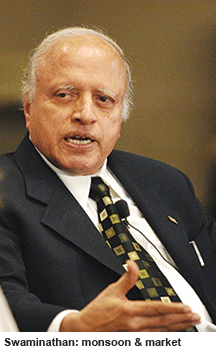 Similarly, Sanjit (‘Bunker’) Roy, the iconic founder-director of the Tilonia (Rajasthan)-based Social Work and Research Centre aka Barefoot College (BC, estb. 1972) which is more appreciated abroad than in India for training thousands of rural solar engineers, rainwater engineers, village farmers, dentists, doctors and artisans, ascribes the poverty and despair of India’s farmers and village communities to factors larger than formal primary education. “Here we don’t accept that village farmers, artisans and service providers are uneducated even if they are illiterate. On the contrary, we believe most village folk are well educated having inherited traditions of crafts, water management, weather forecasting and agriculture knowhow and survival which are thousands of years old. In BC, our objective has been to revisit education by reviving the native skills of village India to tangibly improve people’s lives by enabling them to generate solar energy, manage water resources and build capacity for sustained development,” said Roy, when interviewed by EducationWorld three years ago (see educationworldonline.net archives, February 2012).
Similarly, Sanjit (‘Bunker’) Roy, the iconic founder-director of the Tilonia (Rajasthan)-based Social Work and Research Centre aka Barefoot College (BC, estb. 1972) which is more appreciated abroad than in India for training thousands of rural solar engineers, rainwater engineers, village farmers, dentists, doctors and artisans, ascribes the poverty and despair of India’s farmers and village communities to factors larger than formal primary education. “Here we don’t accept that village farmers, artisans and service providers are uneducated even if they are illiterate. On the contrary, we believe most village folk are well educated having inherited traditions of crafts, water management, weather forecasting and agriculture knowhow and survival which are thousands of years old. In BC, our objective has been to revisit education by reviving the native skills of village India to tangibly improve people’s lives by enabling them to generate solar energy, manage water resources and build capacity for sustained development,” said Roy, when interviewed by EducationWorld three years ago (see educationworldonline.net archives, February 2012).
.gif) Invited to comment on the spate of farmer suicides across the country for this feature, Roy says: “The poor productivity of Indian agriculture is due to the total lack of sympathetic and positive support from rural banks coupled with farmers’ desperation and dependence on private money lenders. Sadly, agricultural research is directed to the improvement of productivity of rich farmers. For 98 million farmers who own less than 1 hectare of land, there is no support from agricultural universities either.”
Invited to comment on the spate of farmer suicides across the country for this feature, Roy says: “The poor productivity of Indian agriculture is due to the total lack of sympathetic and positive support from rural banks coupled with farmers’ desperation and dependence on private money lenders. Sadly, agricultural research is directed to the improvement of productivity of rich farmers. For 98 million farmers who own less than 1 hectare of land, there is no support from agricultural universities either.”
Adds Dr. Pratap Bhanu Mehta, president of the highly-rated Delhi-based think-tank Centre for Policy Research: “I’m not sure that poor productivity in agriculture can be linked to declining learning outcomes. The decline is taking place in the context of expansion, and there are other structural reasons why agriculture is in crisis. Nevertheless India’s education system is a scandal. This government seems no different.”
Discomfiting as it is to beg to differ with these eminent economists and development scientists who have devoted a lifetime of work to agriculture and national development, it is nevertheless submitted that the causes of the epidemic of rural suicides identified by them are proximate rather than fundamental. While it’s undeniable that the inadequacy of credit flow, neglect of irrigation and failure of the outreach programmes of the country’s 62 agriculture universities have substantially disabled India’s hard-working farmers, the root cause of their pervasive poverty, misery and poor productivity is mass denial of basic literacy and numeracy — primary /elementary education.
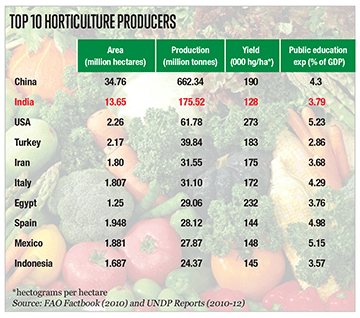 This has disempowered hundreds of millions of rural citizens from articulating, negotiating and demanding their rights, including their right to a fair share of bank credit, assured irrigation, and law, order and justice. Surely it’s self-evident that citizens unable to read, write and manage simple arithmetic cannot effectively demand their rights from the all-pervasive government system, particularly from rogue government officials who have become a law unto themselves.
This has disempowered hundreds of millions of rural citizens from articulating, negotiating and demanding their rights, including their right to a fair share of bank credit, assured irrigation, and law, order and justice. Surely it’s self-evident that citizens unable to read, write and manage simple arithmetic cannot effectively demand their rights from the all-pervasive government system, particularly from rogue government officials who have become a law unto themselves.
Yet even if most establishment economists, social scientists and intellectuals who dominate the national development discourse and influence public policy are reluctant to distinguish between the proximate and fundamental causes of the suicides epidemic sweeping rural India, some new generation social scientists are inclined to make the linkage between this malaise and the continuous neglect and denial of acceptable quality public — especially primary education — to two generations of rural citizens. 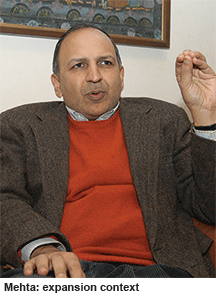
“Fundamentally, quality of learning at the primary stage is a key determinant of productivity along an individual’s entire career trajectory. Therefore in a structural sense, there is little doubt that learning outcomes in primary education are an important and significant determinant of productivity in any vocation, including agriculture. What Pratham’s annual ASER reports continue to highlight is poor teaching-learning outcomes in rural primaries which cripple hundreds of millions of rural citizens for life, rendering them inadequately skilled to perform economic activities efficiently, leading to a low earnings- low wages trap they find very difficult to escape. While poor agriculture productivity is the outcome of multiple factors, inadequate literacy and skills prevent India’s farmers from availing the benefits of credit and advancements in science and information technologies,” says Samar Verma, an alum of Delhi University and senior programme officer in the Asia regional office (Delhi) of the Ottawa (Canada)-based International Development Research Centre (estb. 1970).
 Undeniably, the causes of mass agrarian distress which has prompted a huge surge in farmer suicides countrywide and blighted the lives and hopes of tens of millions of children in the forgotten hinterland of 21st century India, are numerous and complex. But if this contagion of rural despair is to be contained, it’s important for the Central and state governments as also the establishment which shapes public policy, to get their priorities right.
Undeniably, the causes of mass agrarian distress which has prompted a huge surge in farmer suicides countrywide and blighted the lives and hopes of tens of millions of children in the forgotten hinterland of 21st century India, are numerous and complex. But if this contagion of rural despair is to be contained, it’s important for the Central and state governments as also the establishment which shapes public policy, to get their priorities right.
The first step that needs to be taken to address the paradox of 60 percent of the population which resides in rural India, contributing a mere 14 percent of the country’s GDP, is to sharply enhance low yields and productivity in the country’s small and medium farms. The necessary precondition of this outcome is radical improvement in the quality of primary education being dispensed to over 100 million children in 1.20 million mainly state government primary and upper primary (classes I-VIII) schools of rural India.
In turn, this necessitates that the annual education outlay of government (Centre plus states) doubles from the current 3 precent to 6 percent per year as recommended by the high-powered Kothari Commission way back in 1966. In this connection, it’s pertinent to note that in its General Election 2014 manifesto, the BJP which came to power last summer with an absolute majority in the Lok Sabha, promised to fulfil the recommendation of the Kothari Commission. Yet in its first full-fledged Union budget 2015-16, for the first time in the history of post-independence India, it actually reduced the Centre’s budget for education from Rs.82,771 crore in 2014-15 to Rs.69,075 crore this year.
The routine argument advanced for the continuous under-investment in human capital development (public education and health) is paucity of resources. But as it has been repeatedly argued in this publication and recently demonstrated in a detailed special report feature on the Union budget 2015-16 (see EW April), through targeted and purposeful slashing of wasteful government expenditure and unmerited subsidies, imposition of modest flat taxes, incremental disinvestment of public sector enterprises etc, it’s entirely possible to mobilise a one-time capital receipt of Rs.232,368 crore to make government schools countrywide RTE Act compliant (Rs.1,10,000 crore). The remainder of the sum raised could be deployed to also shore up the country’s pathetically ill-equipped 1.6 million anganwadis (early childhood nutrition and learning centres — Rs.70,554 crore), and invest Rs.51,824 crore in rural primary health infrastructure. Yet such is the inertia of the country’s intelligentsia and ivory tower academic community that this proposal has not provoked any comment or debate. 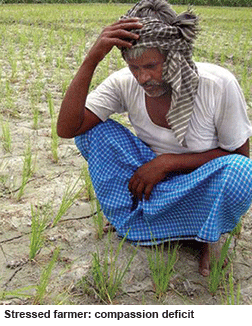
In his new book Looking Away — Inequality, Prejudice and Indifference in New India (Speaking Tiger, 2015), former IAS officer turned human rights activist and writer Harsh Mander, attributes such apathy towards public issues and reluctance to empower and enable less fortunate members of society to “the extraordinary indifference that people of privilege had (have) for the intense and pervasive levels of human suffering around them”. Citing the well-known American philosopher and public commentator Noam Chomsky who remarked that in contemporary India (2013) “misery and oppression are so striking, much worse than in any country I have ever seen”, in the preface to Looking Away, Mander comments: “There is indeed a startling absence of compassion among a majority of well-to-do Indians towards millions who have no advantages of birth to shield them from hunger, repression, violence, squalor and humiliation. A dispassionate external observer would be bewildered by middle-class India’s capacity to look away when confronted with enormous injustice and suffering; by our society’s cultural comfort with inequality.”
 Looking Away is Mander’s exhortation to educated middle class India — an island unto itself — to become concerned about and engaged with the deprivations and iniquities suffered by the overwhelming majority of its fellow citizens, the great number of whom eke out barely subsistence lives in the rural hinterlands of the subcontinent. Although the preamble of the Constitution is premised on the delivery of justice, equality and fraternity to all citizens of the Republic, the conspicuous lack of empathy or fraternity, has ensured the denial of the other two national objectives. Middle class and privileged citizens who read this tract need to become aware that it’s in our own interest that public education in rural India funded through our taxes is continuously measured, raised to global standards and universalised. That is the starting point of a virtuous cycle of rising farm productivity, higher incomes and consequential benefits.
Looking Away is Mander’s exhortation to educated middle class India — an island unto itself — to become concerned about and engaged with the deprivations and iniquities suffered by the overwhelming majority of its fellow citizens, the great number of whom eke out barely subsistence lives in the rural hinterlands of the subcontinent. Although the preamble of the Constitution is premised on the delivery of justice, equality and fraternity to all citizens of the Republic, the conspicuous lack of empathy or fraternity, has ensured the denial of the other two national objectives. Middle class and privileged citizens who read this tract need to become aware that it’s in our own interest that public education in rural India funded through our taxes is continuously measured, raised to global standards and universalised. That is the starting point of a virtuous cycle of rising farm productivity, higher incomes and consequential benefits.
Regrettably, post-independence India’s establishment, intelligentsia and the academy have been driven by a benevolent mai-baap sarkar mind-set to frame national development policies which clearly haven’t worked. Therefore the time has come to change this mind-set en masse and follow the Chinese proverb that it’s better to teach hungry communities how to fish than to distribute fish to them as benevolent largesse.